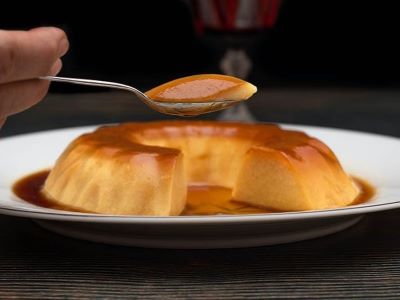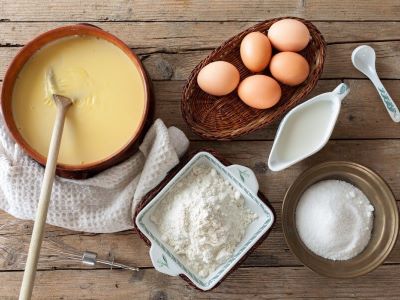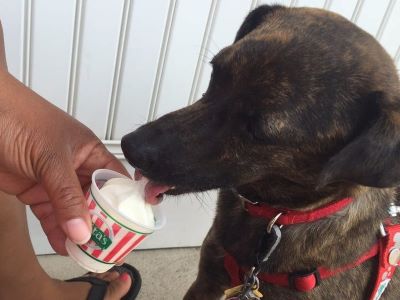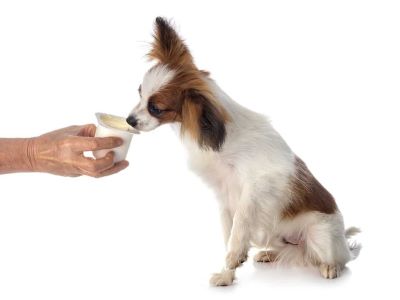With its sweet, creamy texture custard is a beloved dessert for humans. It’s also a food some dog owners may be tempted to share with their pets. But can dogs eat custard and is it truly safe for them? In some cases, it can lead to obesity, diabetes, gastrointestinal upset, and even life-threatening pancreatitis in dogs.
We’ll discuss whether giving your dog custard is healthy or harmful, how much is safe to feed, the risks of custard-like pancreatitis, and healthier treatment alternatives to give your dog instead.

What is Custard?
Custard is a thick, rich, creamy dessert made with milk, eggs, sugar, and flavourings. Traditional versions also incorporate cream for extra smoothness and fat content. Baked custards are cooked in the oven in a water bath to set the eggs gently. Spoonable chilled custards are thickened with cornstarch instead of using heat.

Popular custard styles include crème brûlée, flan, and lemon curd. What attracts people most is the velvety texture and sweet flavour which many of us enjoy. This has led some dog owners to wonder if they can share small amounts of custard with their pets. But can dogs eat custard?
How Much Custard is Safe For Dogs to Eat?
It is generally advised to limit the custard servings to an occasional lick or taste as a rare treat. You should limit the amounts based on your dog’s size:
Small Dogs - No more than 1-2 teaspoons on occasion. Medium Dogs - Up to 1-2 tablespoons maximum. Large Dogs - Up to 2-3 tablespoons at most.
Too much can cause stomach upset like vomiting or diarrhoea. Over the long term excessive custard feeding contributes to obesity, pancreatitis, and other problems.
Ideally, the custard should make up no more than 10% of a dog’s diet. It should never displace balanced, nutritious dog foods but only occasionally supplement them in tiny amounts.
Nutritional Content of Custard

The nutritional content and ingredients of custard for dogs along with some pros and cons as per analysis are as follows:
- Protein – Cooked eggs provide high-quality protein. This supports muscle maintenance and energy.
- Calcium – Milk is a good calcium source for bones and teeth.
- Fat – Most custard contains considerable fat via cream, milk, and egg yolks. Too much fat can lead to obesity and pancreatitis.
- Sugar – Granulated sugar has no nutritional value and can cause blood sugar spikes.
So while custard provides some beneficial protein and calcium, the high sugar and fat negate much of the potential nutritional value. Most dog foods already meet a canine’s protein and calcium needs in healthier ways.
What are the health risks of feeding custard to dogs?
Here are some of the most significant risks of feeding custard to dogs:
- Obesity – The high fat and sugar content leads to excess calories and weight gain.
- Pancreatitis – High-fat foods like custards can cause painful inflammatory conditions.
- Diabetes – Frequent sugar spikes from treats like custard may increase diabetes risk.
- Raw egg risk – Salmonella bacteria in raw eggs can cause food poisoning.
- Choking hazard – The custard texture can pose a choking risk for dogs, especially if gobbling it down quickly.
- Nutritional imbalance – Too much custard may displace balanced meals needed for good nutrition.
So while the occasional small serving may not cause issues, regular custard treats or large portions are quite risky for dogs.
What is the Safest Way to Feed Dogs Custard?

If allowing tastes of custard, reduce risks by:
- Selecting or preparing plain custard without added sugar.
- Never feeding raw egg custard due to salmonella risk.
- Mixing a spoonful of custard thoroughly into their regular dog food instead of feeding alone.
- Refrigerate any leftovers promptly and use within 2-3 days to prevent spoilage.
- Adjusting other food on custard days to offset the extra cookies.
- Stopping immediately if symptoms of stomach upset or pancreatitis occur.
Being mindful of portion size, preparation, and storage helps make custard an occasional treat versus an unhealthy dietary habit.
Symptoms of custard poisoning in dogs
Monitor your dog closely for the following adverse reactions after eating custard:
- Vomiting
- Diarrhoea, especially if bloody or mucus-filled
- Loss of appetite
- Excessive gas or abdominal pain
- Lethargy or weakness
These are signs of gastrointestinal upset likely caused by too much sugar, fat, or raw egg bacteria. Stop custard immediately and call your vet if symptoms concern you.
What are the signs of custard poisoning?

While custard itself is not poisonous to dogs, feeding them too much can cause adverse health effects. Some signs of illness from overindulging in custard could include:
- Vomiting – The high fat and sugar content of custard may cause vomiting, especially if a large amount is consumed.
- Diarrhoea – Custard can lead to loose stools or diarrhoea, which may contain blood or mucus.
- Loss of appetite – Your dog may skip meals or seem disinterested in their regular food after eating too much custard.
- Abdominal pain – The high-fat content of custard can potentially trigger this extremely painful and dangerous pancreatic inflammation or irritation.
- Pancreatitis – The high-fat content of custard can potentially trigger this extremely painful and dangerous pancreatic inflammation. Symptoms include vomiting, abdominal pain, lethargy, diarrhoea, and fever.
If your dog shows concerning symptoms after eating custard, call your vet right away, as prompt treatment greatly improves.
When should you contact a vet?
Contact your veterinarian promptly if your dog shows any concerning symptoms after eating custard. Also, seek advice if you know or suspect your dog ingested a large amount of custard.
Signs requiring emergency vet care include:
- Repeated vomiting or diarrhoea, especially if bloody
- Loss of appetite for more than 24 hours.
- Weakness, lethargy or collapse.
- Crying or whining from abdominal pain
- Fever
- Hunched posture, enlarged abdomen
Catching custard-related issues early improves the chances of a quick recovery, while delayed treatment can allow more severe illness to develop. So don’t hesitate to call your vet if your dog seems unwell after eating custard.
Alternatives to custard for dogs

If you want to spoil your dog with a creamy food treat, try healthier alternatives like [1]:
- Plain yoghurt – Provides probiotics and calcium without high sugar when unsweetened.
- Pumpkin puree – Low-calorie fibre and nutrients.
- Applesauce – Choose unsweetened. Provides potassium and vitamin C.
- Joint supplements – Some cookies, treats and foods for dogs provide glucosamine for joint health.
Talk to your vet about other dog-safe options that provide more nutritional benefits than custard.
What are some healthy treats for dogs?
Some nutritious and dogs-safe alternatives to custard treats include:
- Carrots – Affordable, low-calorie crunchy treat. Good source of fibre, vitamin A, and minerals. Can promote dental health by scraping plaque. Offer washed, raw, and cut into bite-size pieces.
- Apples – Provide vitamins A, C and fibre. Cut into wedges and remove seeds and core first, which contain toxic cyanide. Monitor for any gastrointestinal upset.
- Bananas – High in potassium, magnesium, and vitamins. Mash thoroughly before feeding to avoid choking risk. Easy to digest and gentle on stomachs.
- Blueberries – Low calorie, high in antioxidants. Frozen blueberries make a cooling summer treat. Monitor stool for blue hints!
- Sweet potatoes – Baked, mashed, or frozen, great source of fiber, vitamin A and beta-carotene. Avoid seasoning or toppings.
- Pumpkin – Pureed canned pumpkin soothes digestive upsets. Provides vitamin A, antioxidants and fibre without many calories.
- Unsweetened Greek yoghurt – Probiotics support healthy digestion and immunity. Lactose-free varieties are available. Mix with fruits or peanut butter.
- Peanut butter – Lool for all-natural brands without added salt or sugar. Good source of protein and healthy fats. Can help disguise pills!
- Lean meat – Unseasoned boiled chicken, turkey, or lean beef provide protein while helping promote dental health through chewing action.
FAQs
Can dogs eat custard?
Yes, dogs can eat small amounts of custard occasionally as a treat. But it should not become a regular part of their diet.
Is custard bad for dogs?
Large amounts of frequent servings of custard can be unhealthy for dogs due to the high sugar and fat content. But small, occasional tastes are not typically dangerous.
Will custard be bad for dogs?
Eating too much custard may cause vomiting, diarrhoea, gas or pancreatitis in dogs. But a lick or spoonful once in a while is unlikely to cause illness in most healthy dogs.
Can I give my dog custard every day?
No, custard should only be given occasionally, at most once a week. Regular consumption can lead to obesity, diabetes, pancreatitis, and other health issues.
What happens if a dog eats a whole bowl of custard?
Consuming a large amount may cause vomiting, diarrhoea and stomach upset. Seek vet advice, pancreatitis is also possible. Stop giving your dog any further custard.
Conclusion
Custard’s sweet taste and creamy texture may seem appealing. But it’s best to save this dessert just for human enjoyment. Custard poses too many risks for our canine companions. It can lead to obesity, diabetes, gastrointestinal upset, and even life-threatening pancreatitis in dogs.
Giving your dog the occasional small taste of custard probably won’t cause harm. But custard should never become a regular part of their diet or snacks. Instead, give your dog foods and treats made specially for their nutritional needs. Balanced dog food, healthy fruits, vegetables, proteins and dog teats will provide great flavour. They’ll also offer optimal nutrition without custard’s dangers.
References:
- Dog Nutrition: Guide to Dog Food Nutrients | petMD



